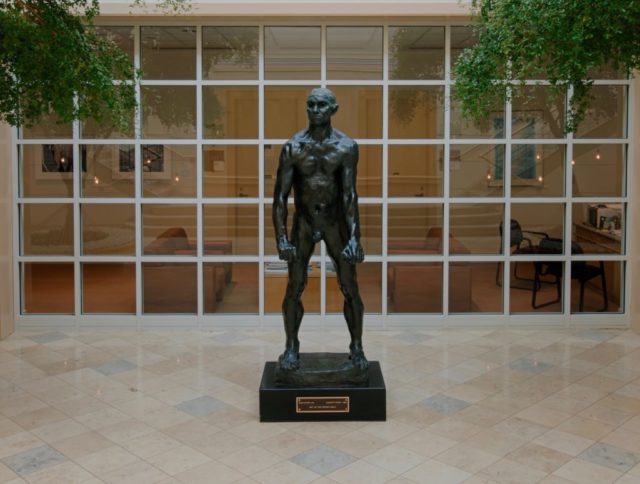As I progress through my final days as a student at Davidson, I am acutely aware of the most remarkable parts of being a student here. Among the things I’ll miss the most, my daily walk past Auguste Rodin’s sculpture of Jean d’Aire ranks high.
Rodin’s sculpture entered the Davidson collection in 1993 on a generous gift of the Pepper Family. However, the story of our Jean d’Aire goes back to the 14th century. As the story goes, during the Hundred Years’ War, King Edward III of England besieged the French city of Calais. Months later and after near starvation, six leading citizens of Calais, the Burghers were ordered to go to Edward’s camp with nooses around their necks to spare the rest of the town’s people.
Our Jean d’Aire is an individual figure study for a colossal monument commissioned by the city of Calais in 1884 to commemorate this event. Rodin’s finished monument depicted the six Burghers as they make the march in chains and nooses to the English King’s camp, at the moment when death seems almost certain.
As one who has spent more time in the Visual Arts Center over these past four years than I would like to admit, I can attest to Jean d’Aire’s role as a cornerstone in Davidson’s visual arts program. Most students on campus may remember Jean d’Aire as a stop on their campus tour. For myself, I recall the first time my Art History class gathered in the atrium, and I was allowed to put my bare hands on the towering bronze sculpture. At the time, I was utterly shocked by the suggestion of touching such an important work of art. However, this lesson taught me how important it is to be there, physically, with a work of art to experience it fully. Without this memorable lesson, I never would have noticed the force it took Rodin to mold Jean d’Aire, or the intricacies of the piece when it catches the light from the mighty glass roof overhead.
Whether standing directly in front of the sculpture or just breezing past on your way to class, Rodin’s Jean d’Aire offers an unflinching look at a troubling subject, endowed with humanity. Rodin always rendered his figures in nude first. Despite the vulnerability that is highlighted by the clear anguish of his features and distorted proportions, Jean d’Aire still has a certain strength to him—heroism and fortitude, even in defeat. Starting with the moment we sign the Honor Code, Davidson students are expected to uphold the same honor and integrity as that exemplified by Jean d’Aire, especially in our darkest and most vulnerable moments.
As graduation quickly approaches, I feel compelled to share my enthusiasm for this work for two reasons. First, being a student at Davidson has allowed me to see a Rembrandt or Motherwell between morning classes, hear evening artist talks just a five-minute walk from my dorm, and touch a Rodin sculpture with my bare hands. The access that Davidson students have to our art collection is something I’ll miss intensely when I graduate this spring, and nothing encapsulates this unprecedented access more than the Rodin sculpture. Secondly, another powerful reminder of Rodin’s impressive career will make its way onto our campus in January 2020 in the form of a 22-piece exhibition on loan from the Canter Foundation. I sincerely hope that this retrospective of Rodin’s artwork will help the public understand Rodin’s achievements, as well as inform them on the cornerstone of our own collection, Jean d’Aire.
This installment of Seen on Campus is brought to you by Carolina Adams ’19.

